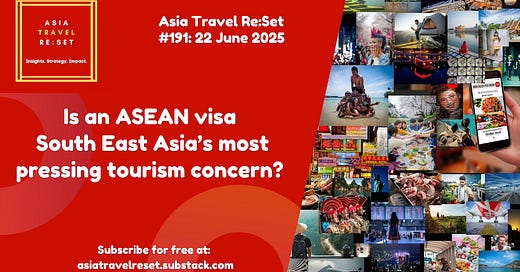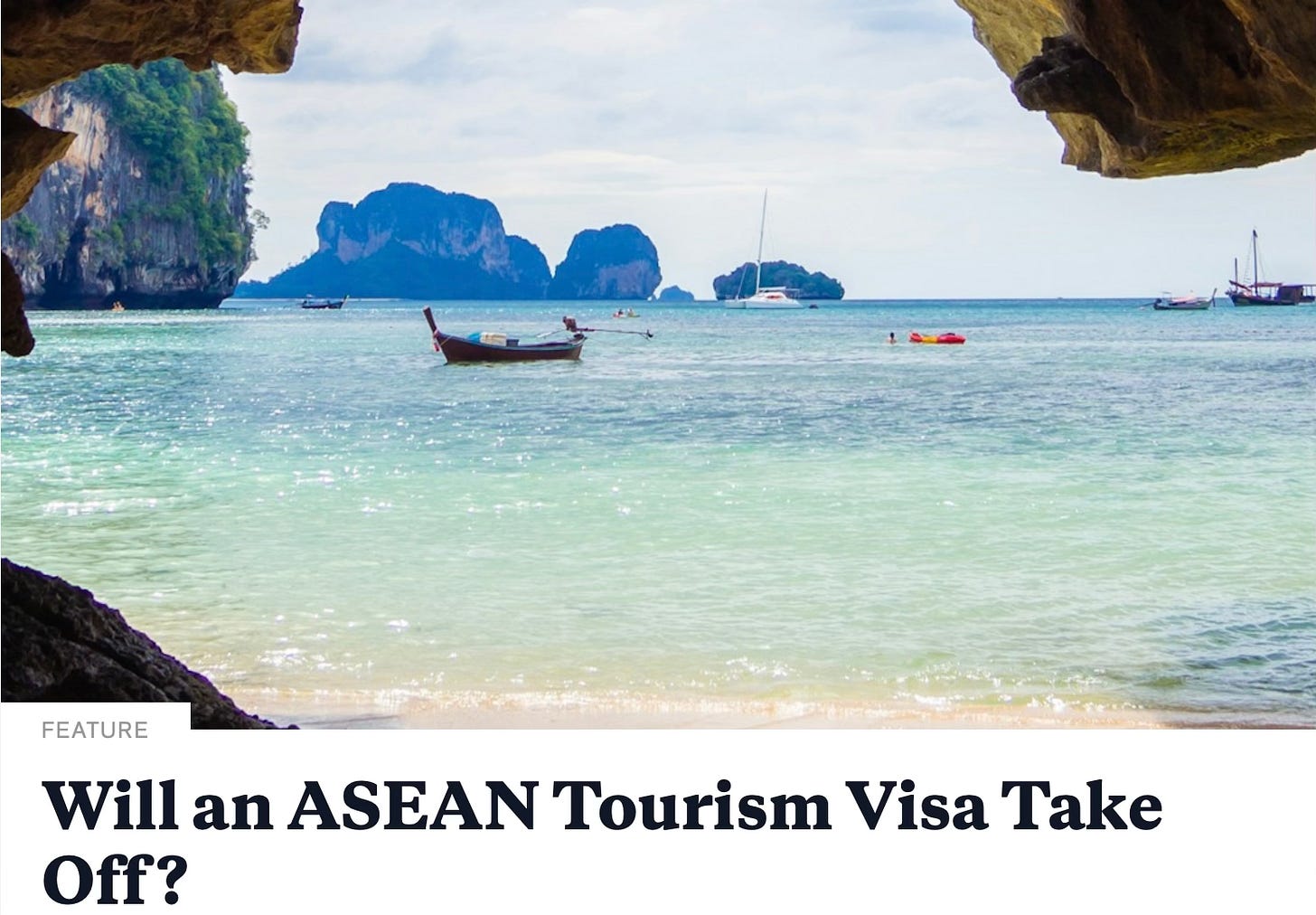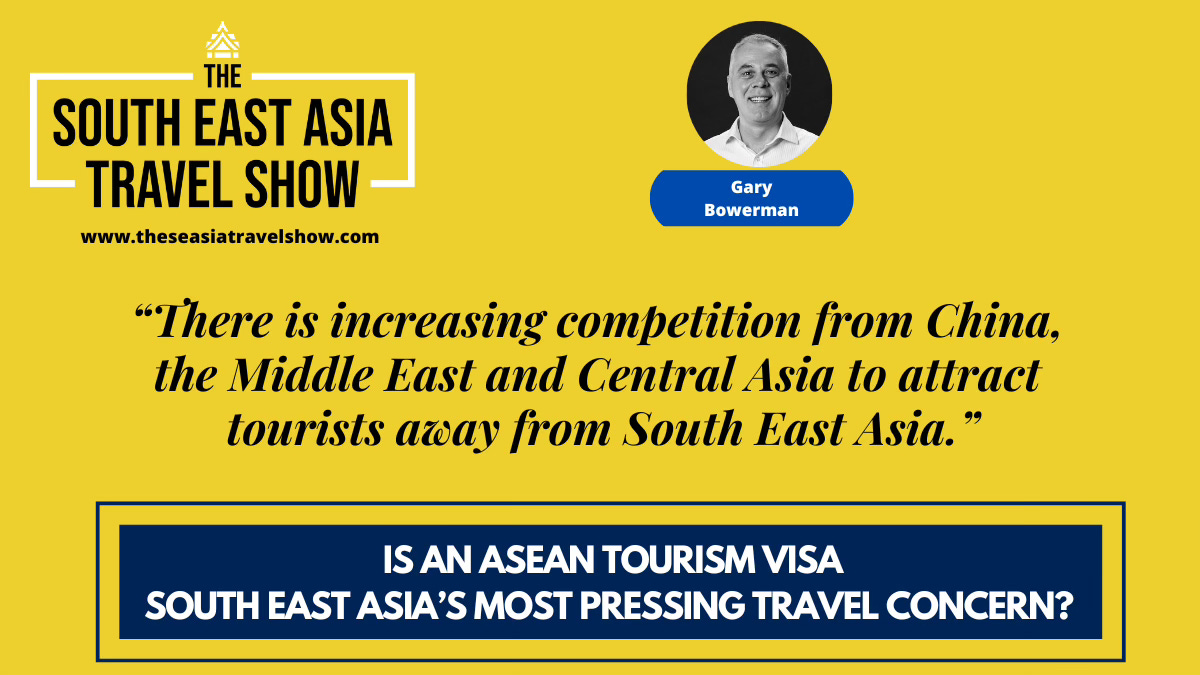Issue #191: Is an ASEAN Visa South East Asia's Most Pressing Tourism Concern?
Will a South East Asian regional tourism visa ever take off?
Welcome to Issue 191 of Asia Travel Re:Set
Will a South East Asia tourism visa ever happen?
Despite referencing the word “tourism” 26 times in its new Vision 2045 plan for greater regional integration, ASEAN is reticent to discuss a “borderless” tourism visa.
But, as pressures start to build on its post-Covid recovery, South East Asian nations are seeking new tourism stimuli. Is a collectivist approach the way forward?
Thanks for checking in…
In recent months, media hype has built around the possibility of the 10 countries (perhaps soon to be 11) of South East Asia launching a regional visa for tourists.
The context is that each country wants to expand tourism to attract investment and support economic development. Enabling visitors to travel "borderless" through the region would, in theory, unlock more tourism and revenue generation.
But the ASEAN Secretariat remains tight-lipped, despite noting in May that easing travel access “offers numerous benefits to regional socio-economic development.”
So let’s break it down into 6 key segments and 24 bullet-points.
1) Historic Context
An ASEAN tourism visa has been widely debated since the EU introduced the Schengen visa in 1995.
In 2016, the World Economic Forum published a paper entitled ASEAN may have 10 nations but it should only have one visa.
In 2024, Thailand’s then Prime Minister Srettha Thavisin proposed a common visa for 6 nations: Thailand, Cambodia, Malaysia, Myanmar, Vietnam and Laos.
This “Six Countries, One Destination” model underpins the recent hype.
2) Post-Covid Imperative
Covid border closures decimated the travel industry. In 2019, South East Asia attracted 144 million international visitors. In 2021, just 2.9 million.
The post-pandemic recovery has been measured. In 2024, 121 million visitors arrived, or 84% of 2019.
The tourism recovery is notably stronger in some countries than others.
By 2030, ASEAN targets “10.3% of global tourists” totalling 187 million arrivals.
3) The Schengen Model
Regional media continues to discuss the introduction of a “Schengen-style visa”.
Schengen encompasses 25 EU countries and 4 associated nations.
Thailand’s original 6-nation plan omitted Singapore, Indonesia and the Philippines - which are 3 of ASEAN’s 5 founding nations - and Brunei.
Unlike the EU, ASEAN does not have supranational institutions, like the European Commission, Council, Parliament and Court of Justice, to which member nations devolve legal powers to make and enforce binding policy decisions. Nor does it have a central bank to manage project financing.
⏩ Click on the live link below to listen to Is an ASEAN Tourism Visa South East Asia’s Most Pressing Travel Concern?
Or search for The South East Asia Travel Show on any podcast app.
4) 2045 Community Vision
Published at the annual ASEAN Summit in KL in May, the ASEAN Community Vision 2045 is an aspirational 20-year blueprint for greater economic integration.
As ASEAN strives to become the world’s 4th-largest economy by 2045, it says member states “need to deepen their economic integration and enhance their agility to address multifaceted challenges”.
It also needs “to strengthen institutional capacity and effectiveness, and make ASEAN organs, bodies and mechanisms more decisive, responsive and timely as well as future-ready in addressing global and regional challenges.”
However, investing in and standardising security and data-sharing mechanisms at land borders, ports and airports would be a leap of faith for sovereign leaders.
5) External Challenges
China, Japan, South Korea, Australia and nations in the Middle East and Central Asia are all seeking to entice tourists away from South East Asian destinations.
China unilaterally introduced a new ASEAN visa for business travellers from 11 South East Asian nations.
China also concluded visa-free access for all 6 GCC countries, Saudi Arabia, UAE, Kuwait, Bahrain, Oman and Qatar.
The GCC countries are expected to introduce their own regional tourism visa.
6) The Way Forward?
Unless all 10 nations are included, ASEAN cannot countenance a common visa. Meantime, Myanmar is suspended from regional meetings, and Thailand and Cambodia are embroiled in a border dispute.
For now an ASEAN visa seems remote, but it could gain impetus as the regional chair rotates to a nation geographically distinct from mainland South East Asia.
The Philippines is investing in tourism capacity-building infrastructure and services to support national economic development – and views an ASEAN visa as a conduit to achieving its objectives.
“We hope that the subject of an ASEAN visa will come up again when the Philippines hosts the ASEAN Summit in 2026,” Christina Frasco, Secretary of Tourism for the Philippines, told the Skift Asia Forum in Bangkok in May.
And, that’s a wrap for Issue 191.
Asia Travel Re:Set will return next Sunday. Meantime, find me on LinkedIn.
Happy travels,
Gary






